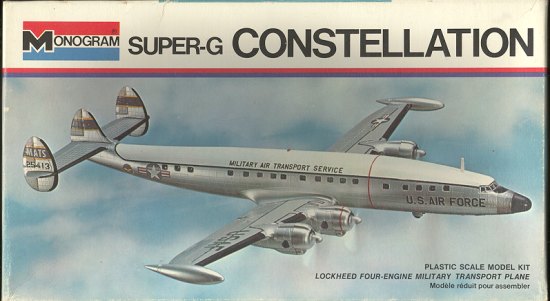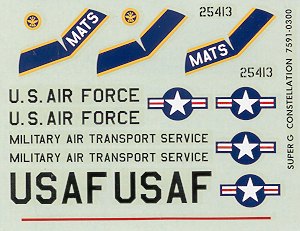
|
KIT: |
Monogram 1/131 C-121 Connie |
|
KIT # |
7591 |
|
PRICE: |
Long OOP -bought at a swap meet |
|
DECALS: |
one aircraft |
|
REVIEWER: |
|
|
NOTES: |
boxing date is 1957/1975 |

|
HISTORY |
Naturally, the military had to have a few as well and these were
purchased as the C-121C and put into service with MATS (Military Air
Transport Service), a forerunner of MAC and now AMC. After giving
sterling service, the planes were either transferred to the Navy, Air
National Guard, or sold to civilian operators. The last passenger/cargo
121 was retired from USN service in the mid 1970s.
|
THE KIT |

This has to be another of Monogram's early aircraft kits. It has been issued as both the military version you see here and in TWA livery as an airliner. The kits are, for all purposes, identical except for the decal sheet. Typical of a 1957 kit, it is festooned with rivets, though they are rather subdued, for a kit of this time. This 1975 boxing suffers a bit from flash and a few sink marks near the alignment pins. Though devoid of any interior, there are separate doors and a set of stairs, which is designed to slot into the aft entry way and also hold up the tail of the plane. The civil kit also includes some fight attendants if I'm not mistaken, though those are not part of this kit.
The kit also includes cabin windows as well as cockpit windows so masking
will be an interesting exercise. No nose weight is suggested, but I'd be
more than willing to bet that it will require a considerable amount to
prevent tail si tting.
The landing gear appear to be sturdy enough to support the weight needed.
Engine detailing is minimal and wheel wells are also without detail, though
not open as in some kits. Many of the smaller parts are marred by ejector
pin marks on the outside, effectively ruining any detail that is there.
tting.
The landing gear appear to be sturdy enough to support the weight needed.
Engine detailing is minimal and wheel wells are also without detail, though
not open as in some kits. Many of the smaller parts are marred by ejector
pin marks on the outside, effectively ruining any detail that is there.
The instructions are most complete with detailed assembly drawings and a step by step construction outline. No color info is given other than for the exterior and that in generic terms. Basically you have one aircraft in bare metal with a white upper surface to the fuselage. Decals are well printed and in good register. I'd hope that they were still in good shape as finding aftermarket ones for this kit is problematical at best. Frankly, I'm not really sure of the scale, but it is undoubtedly something odd like 1/139. It is not that far away from 1/144 so shouldn't look to weird in your collection.
|
CONCLUSIONS |
This is a nostalgia trip for most of us. The shape of the kit looks right and judging from what I've been told about the Minicraft kit, may still be the best shape small scale Connie around. I'd hesitate to put a lower age requirement on this and any other older kit as I know a bunch of 7-8-9 year olds who built these and a lot of similar models!
Review kit courtesy of me.
If you would like your product reviewed fairly and quickly by a site that has over 200,000 visitors a month, please contact me or see other details in the Note to Contributors.